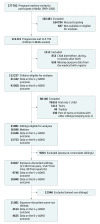Association of Gestational Age at Birth With Symptoms of Attention-Deficit/Hyperactivity Disorder in Children
- PMID: 29946656
- PMCID: PMC6142916
- DOI: 10.1001/jamapediatrics.2018.1315
Association of Gestational Age at Birth With Symptoms of Attention-Deficit/Hyperactivity Disorder in Children
Abstract
Importance: Preterm birth is associated with an increased risk of attention-deficit/hyperactivity disorder (ADHD); however, it is unclear to what extent this association can be explained by shared genetic and environmental risk factors and whether gestational age at birth is similarly related to inattention and hyperactivity/impulsivity and to the same extent in boys and girls.
Objectives: To investigate the association between gestational age at birth and symptoms of ADHD in preschool and school-age children after adjusting for unmeasured genetic and environmental risk factors.
Design, setting, and participants: In this prospective, population-based cohort study, pregnant women were recruited from across Norway from January 1, 1999, through December 31, 2008. Results of a conventional cohort design were compared with results from a sibling-comparison design (adjusting for genetic and environmental factors shared within families) using data from the Norwegian Mother and Child Cohort Study. Data analysis was performed from October 1, 2017, through March 16, 2018.
Exposures: Analyses compared children and siblings discordant for gestational age group: early preterm (delivery at gestational weeks 22-33), late preterm (delivery at gestational weeks 34-36), early term (delivery at gestational weeks 37-38), delivery at gestational week 39, reference group (delivery at gestational week 40), delivery at gestational week 41, and late term (delivery after gestational week 41).
Main outcomes and measures: Maternally reported symptoms of ADHD in children at 5 years of age and symptoms of inattention and hyperactivity/impulsivity at 8 years of age. Covariates included child and pregnancy characteristics associated with the week of delivery and the outcomes.
Results: A total of 113 227 children (55 187 [48.7%] female; 31 708 [28.0%] born at gestational week 40), including 33 081 siblings (16 014 female [48.4%]; 9705 [29.3%] born at gestational week 40), were included in the study. Children born early preterm were rated with more symptoms of ADHD, inattention, and hyperactivity/impulsivity than term-born children. After adjusting for unmeasured genetic and environmental factors, children born early preterm had a mean score that was 0.24 SD (95% CI, 0.14-0.34) higher on ADHD symptom tests, 0.33 SD (95% CI, 0.24-0.42) higher on inattention tests, and 0.23 SD (95% CI, 0.14-0.32) higher on hyperactivity/impulsivity tests compared with children born at gestational week 40. Sex moderated the association of gestational age with preschool ADHD symptoms, and the association appeared to be strongest among girls. Early preterm girls scored a mean of 0.8 SD (95% CI, 0.12-1.46; P = .02) higher compared with their term-born sisters.
Conclusions and relevance: After accounting for unmeasured genetic and environmental factors, early preterm birth was associated with a higher level of ADHD symptoms in preschool children. Early premature birth was associated with inattentive but not hyperactive symptoms in 8-year-old children. This study demonstrates the importance of differentiating between inattention and hyperactivity/impulsivity and stratifying on sex in the study of childhood ADHD.
Conflict of interest statement
Figures


Similar articles
-
Association Between Prenatal Exposure to Antipsychotics and Attention-Deficit/Hyperactivity Disorder, Autism Spectrum Disorder, Preterm Birth, and Small for Gestational Age.JAMA Intern Med. 2021 Oct 1;181(10):1332-1340. doi: 10.1001/jamainternmed.2021.4571. JAMA Intern Med. 2021. PMID: 34398171 Free PMC article.
-
Reciprocal relations between dimensions of attention-deficit/hyperactivity and anxiety disorders from preschool age to adolescence: sex differences in a birth cohort sample.J Child Psychol Psychiatry. 2025 Feb;66(2):154-166. doi: 10.1111/jcpp.14038. Epub 2024 Jul 4. J Child Psychol Psychiatry. 2025. PMID: 38965813 Free PMC article.
-
Antecedents of Attention-Deficit/Hyperactivity Disorder Symptoms in Children Born Extremely Preterm.J Dev Behav Pediatr. 2016 May;37(4):285-97. doi: 10.1097/DBP.0000000000000298. J Dev Behav Pediatr. 2016. PMID: 27096570 Free PMC article.
-
Systematic Review and Meta-Analysis: Attention-Deficit/Hyperactivity Disorder Symptoms in Children With Neurofibromatosis Type 1.J Am Acad Child Adolesc Psychiatry. 2025 Apr;64(4):447-462. doi: 10.1016/j.jaac.2024.09.011. Epub 2024 Dec 19. J Am Acad Child Adolesc Psychiatry. 2025. PMID: 39709008
-
ADHD symptoms and diagnosis in adult preterms: systematic review, IPD meta-analysis, and register-linkage study.Pediatr Res. 2023 Apr;93(5):1399-1409. doi: 10.1038/s41390-021-01929-1. Epub 2022 Jan 7. Pediatr Res. 2023. PMID: 34997222 Free PMC article.
Cited by
-
Cognitive performance during adulthood in a rat model of neonatal diffuse white matter injury.Psychopharmacology (Berl). 2022 Mar;239(3):745-764. doi: 10.1007/s00213-021-06053-w. Epub 2022 Jan 22. Psychopharmacology (Berl). 2022. PMID: 35064798 Free PMC article.
-
Association of Parental Preconception Exposure to Phthalates and Phthalate Substitutes With Preterm Birth.JAMA Netw Open. 2020 Apr 1;3(4):e202159. doi: 10.1001/jamanetworkopen.2020.2159. JAMA Netw Open. 2020. PMID: 32259265 Free PMC article.
-
Diagnostic Value of Diffusion Tensor Imaging for Infants' Brain Development Retardation Caused by Pre-Eclampsia.Contrast Media Mol Imaging. 2021 Jul 15;2021:5545178. doi: 10.1155/2021/5545178. eCollection 2021. Contrast Media Mol Imaging. 2021. PMID: 34366725 Free PMC article.
-
The Potential Influence of the Bacterial Microbiome on the Development and Progression of ADHD.Nutrients. 2019 Nov 17;11(11):2805. doi: 10.3390/nu11112805. Nutrients. 2019. PMID: 31744191 Free PMC article. Review.
-
Maternal fever during pregnancy and offspring attention deficit hyperactivity disorder.Sci Rep. 2019 Jul 2;9(1):9519. doi: 10.1038/s41598-019-45920-7. Sci Rep. 2019. PMID: 31266998 Free PMC article.
References
Publication types
MeSH terms
Grants and funding
LinkOut - more resources
Full Text Sources
Other Literature Sources
Medical

